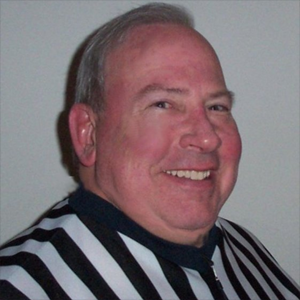
Rndballref
20 Years Experience
Chicago, IL
Male, 60
For twenty years I officiated high school, AAU and park district basketball games, retiring recently. For a few officiating is the focus of their occupation, while for most working as an umpire or basketball referee is an avocation. I started ref'ing to earn beer money during college, but it became a great way to stay connected to the best sports game in the universe. As a spinoff, I wrote a sports-thriller novel loosely based on my referee experiences titled, Advantage Disadvantage
In a local baseball league, they implemented a rule that if a player or parent was tossed from a game, the player was ruled ineligible until the parent umpired a game at his/her level of choice. The league has a handful of letters of apology from parents who tried (quite unsuccessfully) to umpire games.
If I might be so bold as to suggest that you become patched for basketball in your state, attend summer camp to get trained, and work some games next year. You will gain a better understanding of the game, probably help your daughter's game and you will watch her play a little calmer.
Based on your question, I want to referee a game probably more than you want to watch one.
From the federation rule book, "During a dribble the ball may ve batted into the air provided it is permitted tp strike the floor before the is touched again with the dribbler's hand(s).
So, in you question you could retrieve the ball after it strikes the floor or continue dribbling PROVIDING you have not palmed or carried the ball.
I don't know how else to say this...in high school rules, we NEVER award free throws on a player or team control foul. We also NEVER count the basket if a player control foul was called on the shooter.
That is why it does not matter if the team is in the bonus - in any case, free throws are not awarded on a control foul. It is by definition in the rule book - a control foul (team or player) never earns free throws.
Maybe you are confused by the terms - notice I did not say charging fouls instead of control fouls, because charging is just one type of foul committed by the offense. For example, free throws are not awarded for an illegal screen by the offense (as of about five years ago).
Police Officer
 Have you ever been shot or seriously injured on the job?
Have you ever been shot or seriously injured on the job?
iPhone & iPad Technician
 What brand do you think has the poorest quality / workmanship?
What brand do you think has the poorest quality / workmanship?
Obstetrician Gynecologist
 Has being an OBGYN affected your own beliefs about when "life" begins?
Has being an OBGYN affected your own beliefs about when "life" begins?
There are five correctible errors in the NFHS rulebook: 1) failure to award a merited FT, 2) awarding an unmerited FT, 3) permitting the wrong player to shoot a FT, 4) attempting a FT at the wrong basket, & 5) Erroneously counting or cancelling a score. Unfortunately in your scenario, the error was in announcing 2 free throws (he never progressed to awarding the erroroneous 2nd freet throw). So, the error is not correctible, the basket counts, and now belongs to the opposing team. Tough break because of bad officiating.
In high school rules, a player can retrieve the ball after a "legitimate" shot attempt without hitting anything. For example, you could retrieve an airball shot even though the ball has not been touched by another player. However, f the throw to the backboard is not a shot attempt and a player purposely throws it off the backboard, I would call that travelling - much like tossing the ball forward to yourself and moving down the court.
All players inside the 3 point arc (shooter and rebounders) cannot cross the vertical planes into the rectangle (otherwise known as the three second area) until the ball touches the ring. If a rebounder violator is on the same team as the shooter, the free throw is whistled dead and the point cannot count. If there was to be another free throw, then the players line up and it is shot. If this was to be the last free throw, then the ball is awarded to the opponent for a throw in.
If the defensive team (non-shooter) steps into the forbidden area, then the referee holds his fist straight out indicating a delayed violation. If the ball goes in, it counts. If the shot is missed, it is retaken.
If the offense and defense both simultaneously violate the free throw lane restrictions, then the shot is whistled dead it does not count. If there was to be another free throw shot, it is taken. If the free throw was to be the last when opposite teams both violate, then the shot is whistled dead and it goes to the possession arrow.
-OR-
 Login with Facebook
Login with Facebook (max 20 characters - letters, numbers, and underscores only. Note that your username is private, and you have the option to choose an alias when asking questions or hosting a Q&A.)
(A valid e-mail address is required. Your e-mail will not be shared with anyone.)
(min 5 characters)
By checking this box, you acknowledge that you have read and agree to Jobstr.com’s Terms and Privacy Policy.
-OR-
 Register with Facebook
Register with Facebook(Don't worry: you'll be able to choose an alias when asking questions or hosting a Q&A.)